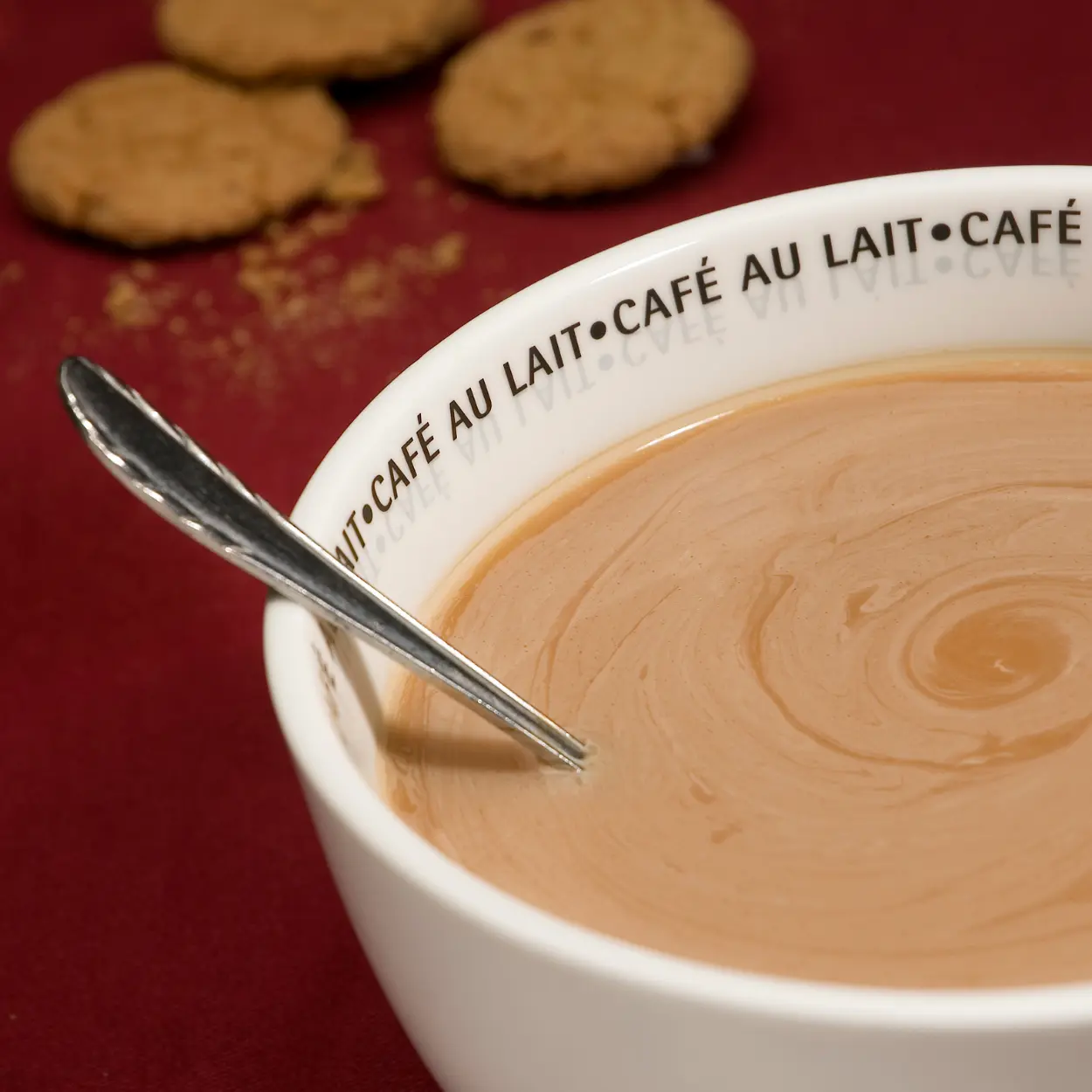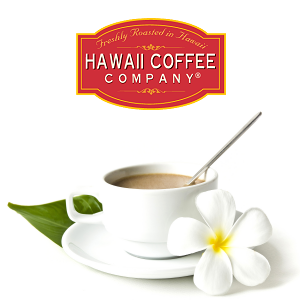Welcome to an in-depth exploration of Café au Lait, a beverage that epitomizes the simplicity and elegance of French culinary culture. Originating in France, this delightful coffee and milk combination has not only found its place at the French breakfast table but has also made a significant impact on coffee traditions worldwide.
So, what is Café au Lait? At its core, it’s a timeless blend of strong brewed coffee and steamed hot milk, often enjoyed in a large bowl known as a ‘bol.’ This article will take you on a historical journey through its early mentions in the 17th-century French literature, its enduring presence in modern-day France, and its various interpretations across global cultures. Prepare to be immersed in the rich, cultural tapestry that makes this concoction so much more than just a coffee drink.
Café au Lait: Key Takeaway
- Balance of Tradition and Versatility: This beverage embodies the elegant simplicity of French coffee culture while allowing for creative adaptations with varying milk-to-coffee ratios and brewing methods.
- Healthful Fusion: This classic drink combines the health benefits of coffee’s antioxidants and mood-enhancing properties with milk’s nutritional richness, making it a well-rounded choice for those seeking a nutritious beverage.
- Cultural Connection: Pronounced as ‘ka-fey oh-lei,’ mastering the pronunciation adds an element of authenticity to the experience, transporting you to a charming French café with each sip.
- Bean and Milk Synergy: The harmony between choosing the right coffee beans and milk plays a pivotal role in crafting the ideal flavor profile and texture, elevating this coffee drink experience.
- Bridging Old and New: This delightful drink bridges the gap between traditional and modern coffee cultures, offering a timeless French tradition that adapts to today’s preferences while retaining its inherent elegance.
What is a Café au Lait: The Historic Roots

Let’s delve into the fascinating world of Coffee and milk, a beverage steeped in tradition and diverse cultural influences. Originating from France, this lovely drink is much more than just coffee; it’s a cultural institution. Here’s a closer look at its history, its role in French culture, and its variations across different societies.
A Brief History of Coffee in France
France has had a long-standing love affair with coffee, dating back to the 16th century. The introduction of coffee into French society revolutionized not just culinary tastes but also social dynamics.
- Marie de Rabutin-Chantal: One of the earliest mentions of this drink appears in the writings of Marie de Rabutin-Chantal, the Marquise de Sévigné, during the early to mid-1700s. (1) It’s interesting to note that this concoction has such early roots, embedding itself in French literary culture.
- Modern Times: Today, coffee remains a prevalent drink, particularly at breakfast. It’s often served in a sizable mug or bowl, ideally suited for dunking pastries—a modern twist on an age-old tradition.
From its historic beginnings to its current status, coffee in France has not just been about the beverage itself, but also about the ritual and social aspects it embodies.
How Café au Lait Became a Staple in French Culture

Café au Lait, or coffee with milk, seamlessly blends into the fabric of French daily life. It is not just a drink; it’s an experience, a morning ritual, and an expression of French culinary heritage.
- Pronunciation and Meaning: In France, This beverage (pronounced /kæfeɪ oʊ ˈleɪ, kæ ˌfeɪ, kə -/) literally means “coffee with milk.” It is usually prepared using strong, brewed coffee and steamed hot milk, often served in a large bowl known as a ‘bol.’
- Traditional Observance: Despite its ubiquitous nature, this delicacy is seldom seen in cafes and more commonly enjoyed at home, particularly during breakfast. Traditionalists consider dipping croissants in this drink a breach of cafe etiquette.
What is in a Café au Lait? It’s a delicious blend of history, culture, and culinary expertise—a drink that captures the essence of French living.
Variations Across Different Cultures
The concept of mixing coffee with milk is universally appealing, but how it’s executed varies from culture to culture. This lovely concoction goes by many names globally and has intriguing regional variations.
- Global Names: In different countries, this beverage adopts different monikers: “Kawa Biala” in Poland, “Milchkaffee” in Germany, and “Café com Leite” in Brazil and Portugal, to name a few. Each version has its unique nuances in preparation and presentation. (2)
- Special Variants: In New Orleans, this coffee drink is not only a drink but also a piece of historical resilience. During the American Civil War, chicory was used as a coffee extender, adding a robust, bitter flavor. Even today, this chicory-infused version is a local favorite, often paired with sugary beignets.
Across different societies, this coffee serves as a fascinating lens to view how a simple combination of coffee and milk can be tailored to reflect diverse cultural tastes and histories.
Distinguishing Café au Lait from Other Coffees
Understanding the nuanced differences among various coffee drinks can elevate your café experience. This delightful concoction is a distinctive coffee beverage that often gets compared with other popular coffee drinks like lattes and cappuccinos. This guide aims to differentiate this drink from its close counterparts by exploring key factors such as ingredients, preparation methods, and even nutritional profiles.
Café au lait vs Latte

When it comes to café au lait vs. latte, the contrast begins with the base. A latte employs a powerful shot of espresso combined with steamed and frothed milk. On the other hand, coffee and milk is a simpler concoction, using brewed coffee and steamed milk, foregoing the foam entirely.
- Milk Volume: Lattes have a greater milk quantity, utilizing 3/4 cup, whereas this type of drink incorporates a mere 1/2 cup.
- Coffee-to-Milk Ratio: Lattes have a ratio of 1:4, significantly milkier than the coffee and milk 1:2 ratio.
- Coffee Base: Lattes often rely on an espresso machine for their strong coffee base, whereas this concoction gives you the freedom to choose any brewing method for its base of brewed coffee.
- Caloric Intake: With more milk, lattes inevitably have a higher calorie count.
- Caffeine Content: Coffee and milk contains 90 mg of caffeine, noticeably more than the latte’s 68 mg.
Coffee and milk generally have a more concentrated flavor due to its lower milk content and higher caffeine level.
Café au lait vs Cappuccino
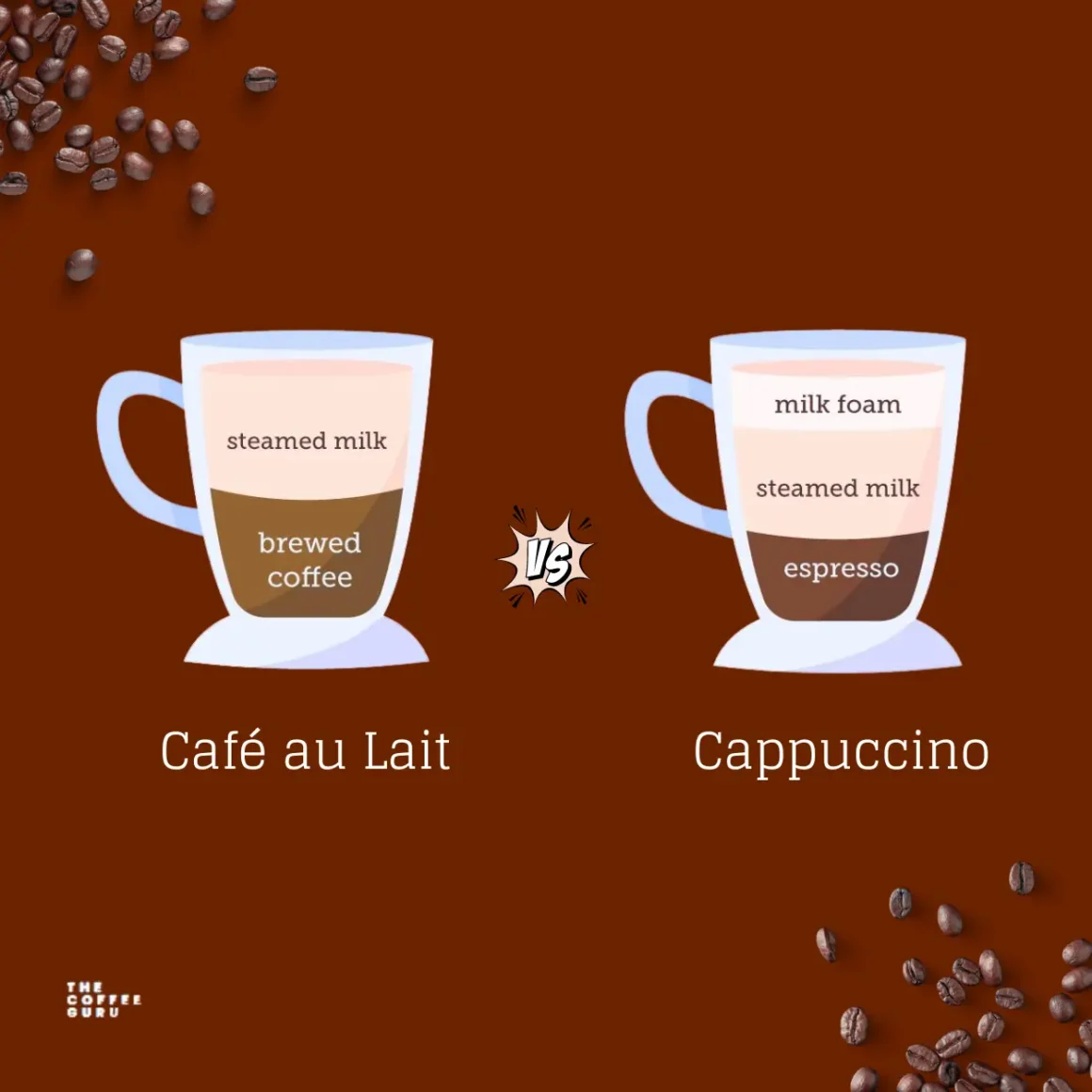
The key difference between café au lait and cappuccinos revolves around their component proportions and types.
- Flavor Intensity: Cappuccinos feature a balanced mix of espresso, steamed milk, and foam, yielding a harmonious taste, unlike This concoction which has a brewed coffee base.
- Texture: Cappuccinos have a rich mouthfeel, achieving creaminess and frothiness simultaneously.
- Caloric and Nutritional Differences: Cappuccinos are lighter on calories, owing to their frothy milk and smaller serving sizes.
- Preparation: Cappuccino-making is an art form involving espresso extraction, milk steaming, and milk frothing to create a beautifully layered cup.
Though both beverages have their unique charm, cappuccinos are best for those seeking a balanced, frothy experience.
Café au lait vs Flat White
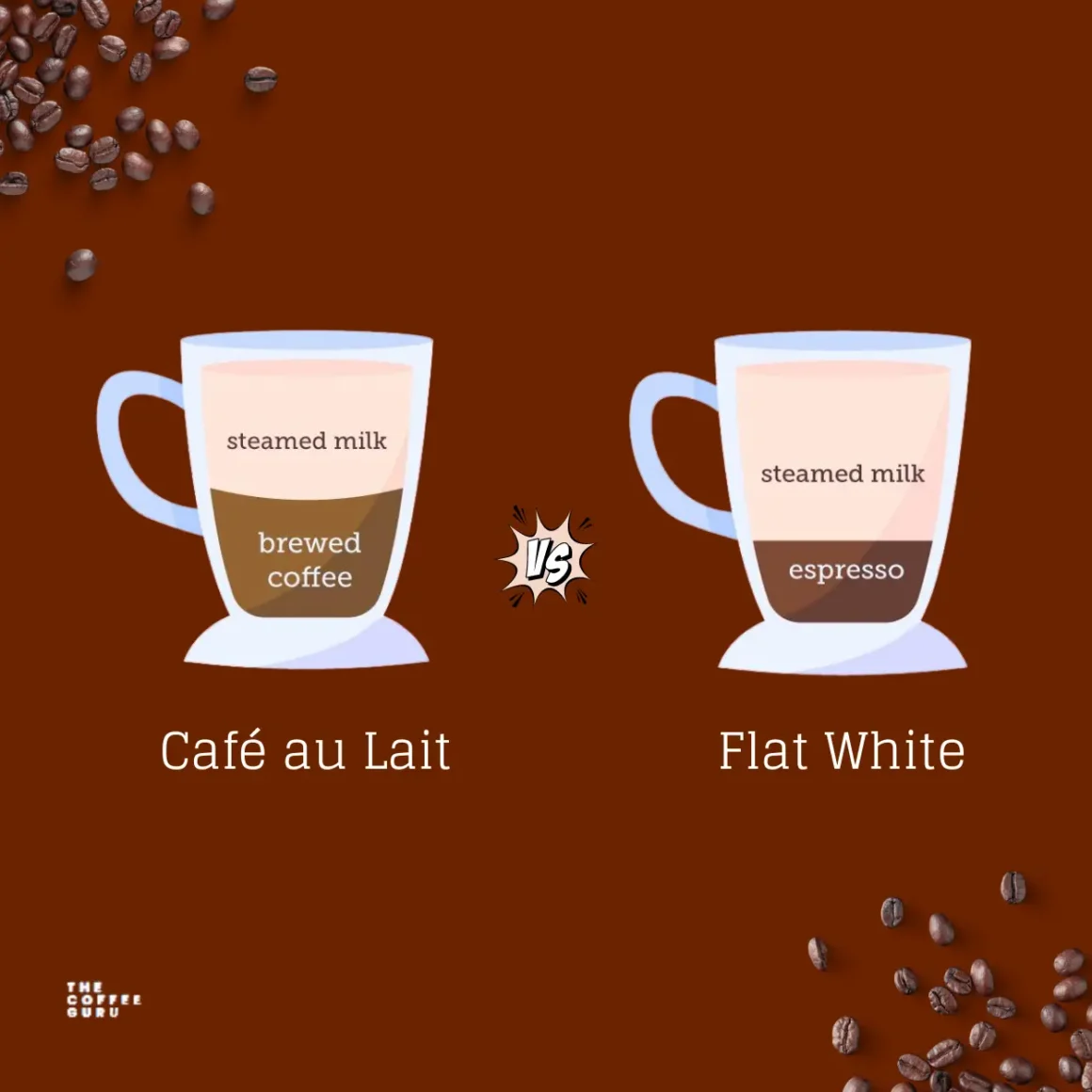
When comparing Café au lait vs. Flat White, several key distinctions emerge.
- Milk Proportion: Flat whites have less milk and a greater emphasis on the espresso’s strong flavor, while coffee and milk have a balanced 1:1 coffee-to-milk ratio.
- Milk Type: Coffee and milk uses steamed milk without any froth. In contrast, flat whites employ a thin, frothy layer of milk.
- Visual Characteristics: Flat whites often feature latte art, making them visually captivating, whereas coffee and milk usually come in a plain mug with no artistic embellishments.
- Flavor: This concoction offers a comforting blend of coffee and milk, in contrast to the robust, forward espresso flavor in flat whites.
- Presentation: Coffee and milk is often served in standard coffee mugs in the United States, while flat whites frequently appear in ceramic cups or glasses.
Each coffee has its own allure, but this delectable coffee drink offers a simpler, more traditional coffee experience.
By understanding these differences, you can better appreciate the unique characteristics of this delectable coffee drink and how it stands apart from lattes, cappuccinos, and flat whites.
The Ideal Milk to Coffee Ratio in Café au Lait

When it comes to perfecting a cup of this tasty beverage, the ratio of milk to coffee plays a significant role in determining the final taste, texture, and experience of the drink. Although there’s a common notion that this drink should be composed of equal parts milk and coffee, individual preferences often dictate a more nuanced approach.
- The 50/50 Standard: A widely accepted starting point for this coffee drink is a balanced 50/50 blend of milk and coffee. This mixture provides an equilibrium between the robust flavor of coffee and the creaminess of milk, making it a go-to option for many coffee enthusiasts.
- For the Strong Coffee Lover: If your palate leans toward a bolder flavor, consider tweaking the ratio to 70% coffee and 30% milk. This will result in a more coffee-forward beverage that still maintains a touch of milk’s softening effects.
- The Milder Side: Conversely, if you prefer your coffee beverages on the lighter side, a 40/60 ratio of coffee to milk could be your sweet spot. This concoction will give you a gentler cup, in which the milk’s smoothness takes center stage.
Choosing the ideal milk-to-coffee ratio in this concoction is largely a matter of personal preference, so don’t hesitate to experiment until you discover the blend that resonates with you. Whether you favor a stronger or milder drink, the key is to find the balance that best suits your taste buds.
The Role of Beans in the Perfect Café au Lait Flavor
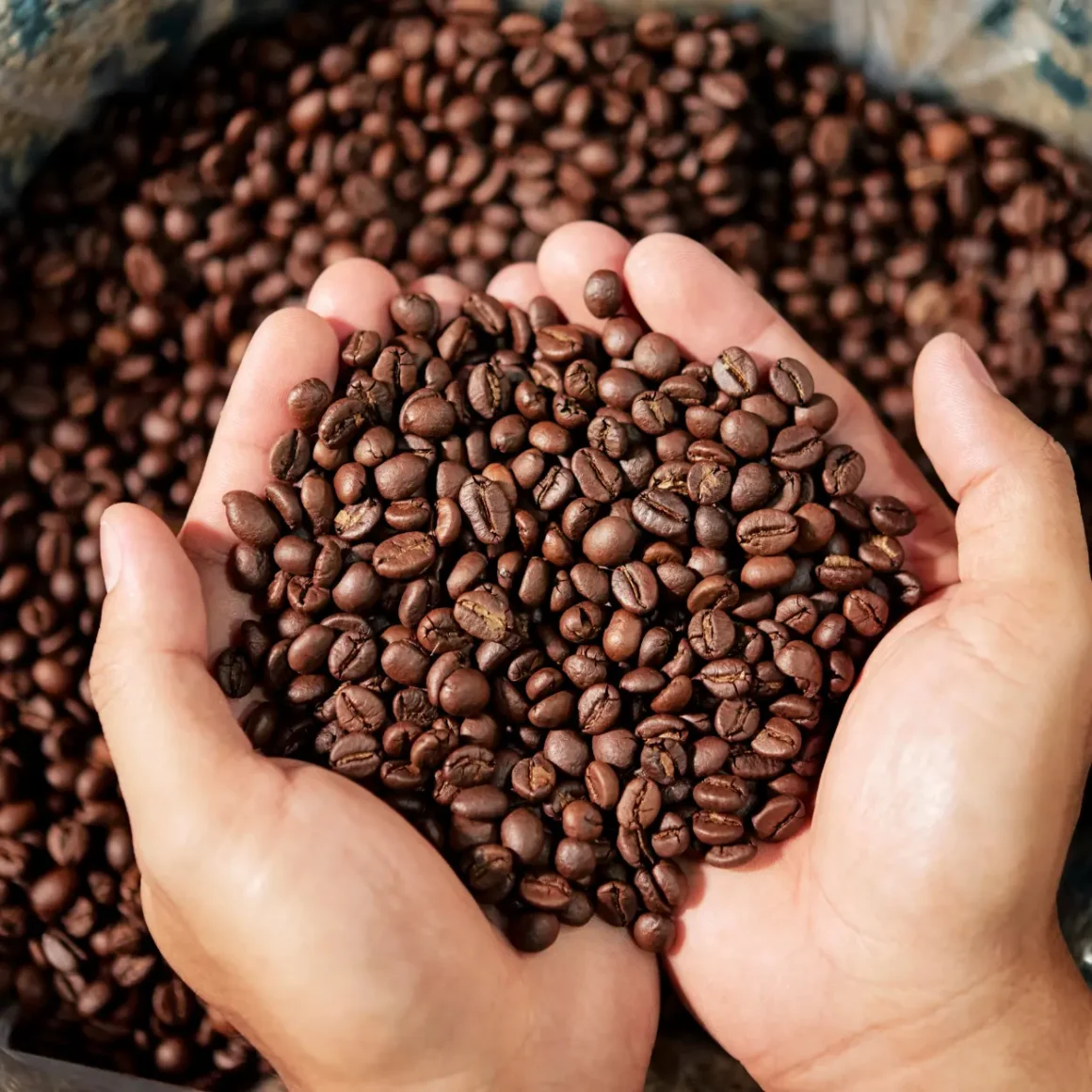
Achieving the perfect cup of this drink is not just about the ratio of milk to coffee; the quality and type of coffee beans you use are equally pivotal. Different beans offer various flavor profiles, acidity levels, and aromatic qualities, all of which contribute to the overall experience of your beverage.
- Single-Origin Beans: If you’re looking for a beverage with a distinct and unique flavor, single-origin beans are a great choice. These beans come from one location, whether it’s a specific country, region, or even a single farm. The flavor profile can range from fruity and floral to earthy and spicy, depending on the origin.
- Blend Beans: On the other hand, blend beans are made by combining beans from different locations. This creates a balanced and harmonious flavor profile. They are designed to bring out the best of each component, creating a cup that is both complex and consistent.
- Roast Level: The roast level also has a significant impact on your cup of joe. A light roast will provide a more acidic and complex flavor, while a dark roast will offer a bolder, more robust experience. Your choice may also depend on the type of milk you use, as certain roasts pair better with whole milk, skim, or even plant-based alternatives.
- Freshness Factor: Coffee beans are at their best shortly after they’ve been roasted. Freshly roasted beans will make your drink taste more vibrant and aromatic. Therefore, it’s advisable to purchase your beans in small amounts and grind them just before brewing.
To elevate your beverage to a gourmet experience, it’s worth spending time exploring different beans and their characteristics. Whether you prefer the consistency of a blended bean or the unique character of a single origin, the choice of bean can make or break your cup of joe. So, take your time, experiment, and find the bean that suits your individual taste profile for that perfect cup.
How to Make a Café au Lait at Home
The joy of savoring this concoction doesn’t have to be limited to French cafes or specialty coffee shops. With the right ingredients, tools, and a bit of know-how, you can prepare this elegant coffee beverage right at home. From choosing the best coffee beans to mastering the ideal brew, this guide offers a comprehensive recipe for this delicious coffee that you can easily follow.
Choosing the Right Coffee Beans and Milk
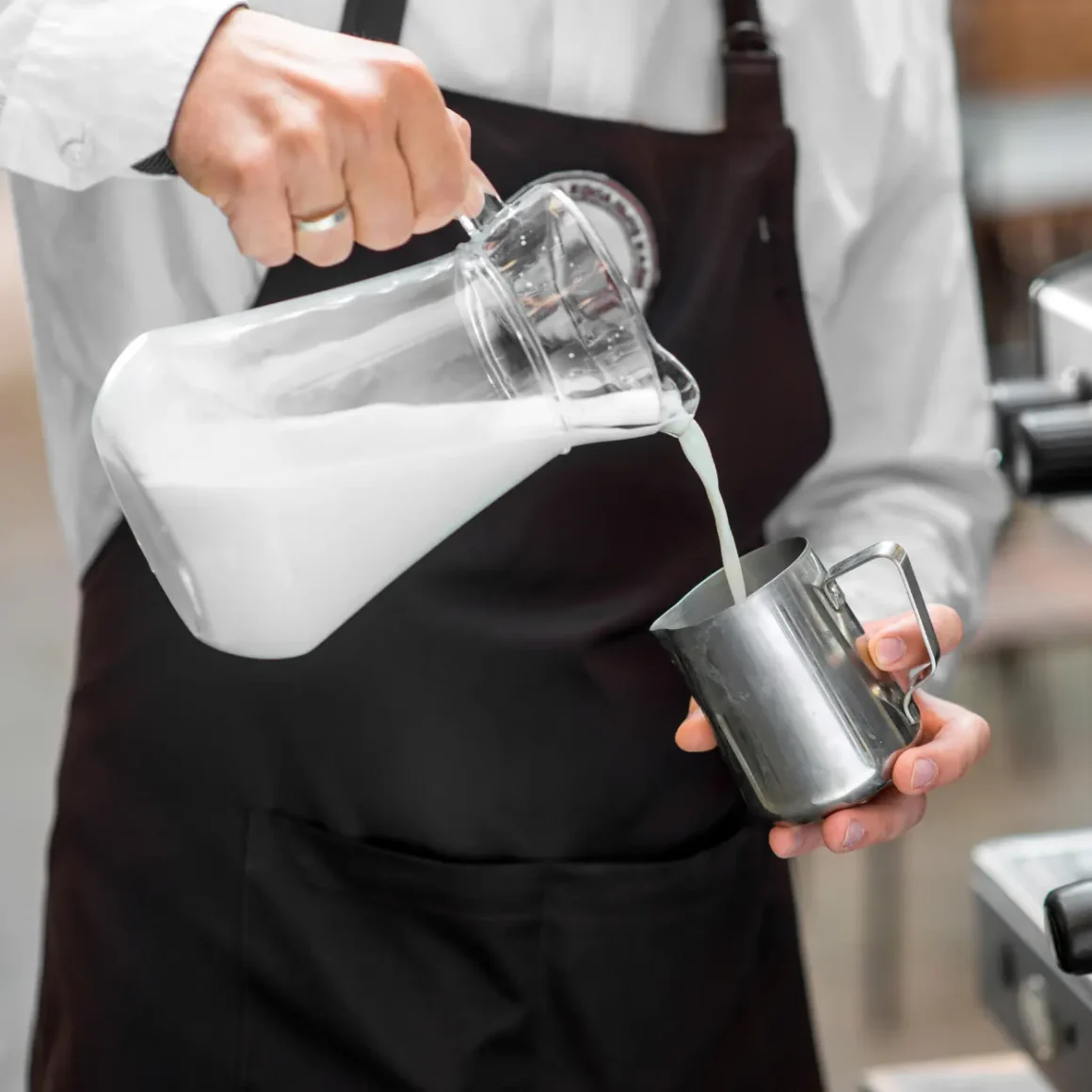
The soul of any good cup of coffee lies in the quality of the beans and milk you choose. But what works for a regular cup may not necessarily work for this type of drink.
Coffee Beans:
- Origin Matters: Coffee beans from different regions have unique flavor profiles. For example, beans from Central America often have fruity undertones which may be overshadowed when combined with milk.
- Richness Over Fruitiness: To enjoy a fuller experience, opt for beans from Java, Brazil, or Sumatra. These beans contribute to a richer and more satisfying flavor.
Milk Types:
- Dairy or Non-Dairy: Whether you prefer cow’s milk or plant-based alternatives, the choice is yours. However, the creamier the milk, the better your drink will taste.
- Barista-Grade Options: For the best results, go for full-fat milk or barista versions of plant-based milks like almonds or oat.
Being selective about your coffee beans and milk type can significantly elevate your homemade beverage.
Tools & Equipment for the Ideal Brew
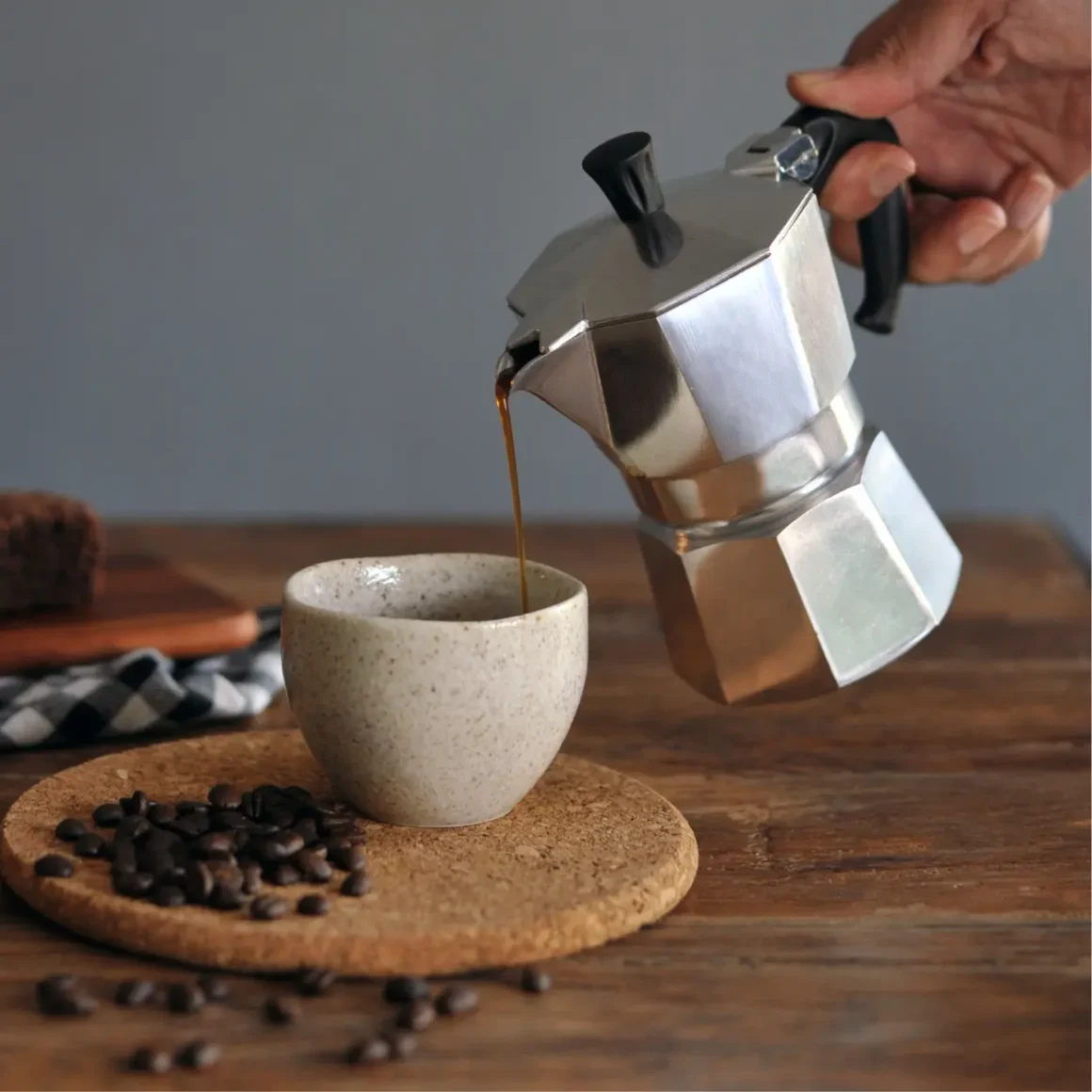
Having the right tools at your disposal can make or break your brewing experience.
Coffee Brewers:
- Moka Pot: Ideal for those who like a strong, espresso-like coffee.
- French Press: Great for those who enjoy a more aromatic and full-bodied brew.
Additional Tools:
- Stovetop Pan: Needed for warming your selected milk.
- Milk Frother: Optional, but useful if you like your milk to have a frothy texture.
- Coffee Mug or Bowl: A regular coffee mug will do, but a bowl offers a touch of authentic French flair.
With the correct equipment in hand, you’re well on your way to mastering how to make this delicious beverage at home.
Step-by-Step Brewing Guide
Now that you’ve gathered your ingredients and tools, let’s get down to the brewing process.
Boil Water:
- Start by boiling water and pouring it into your chosen coffee brewer.
- Allow it to steep for 5 to 10 minutes depending on your brewer and personal preference.
Heat the Milk:
- Use a stovetop pan to warm the milk, removing it from the heat just before it boils.
- If you desire froth, use the milk frother to aerate the milk as it heats.
Combine and Enjoy:
- Press or pour the brewed coffee into your coffee cup or bowl.
- Following a balanced 1:1 ratio, add the heated milk or your chosen dairy alternative.
Relish the fruits of your labor—your freshly made cup of this delicacy is ready to be savored.
Café au Lait’s Place in Modern Coffee Culture
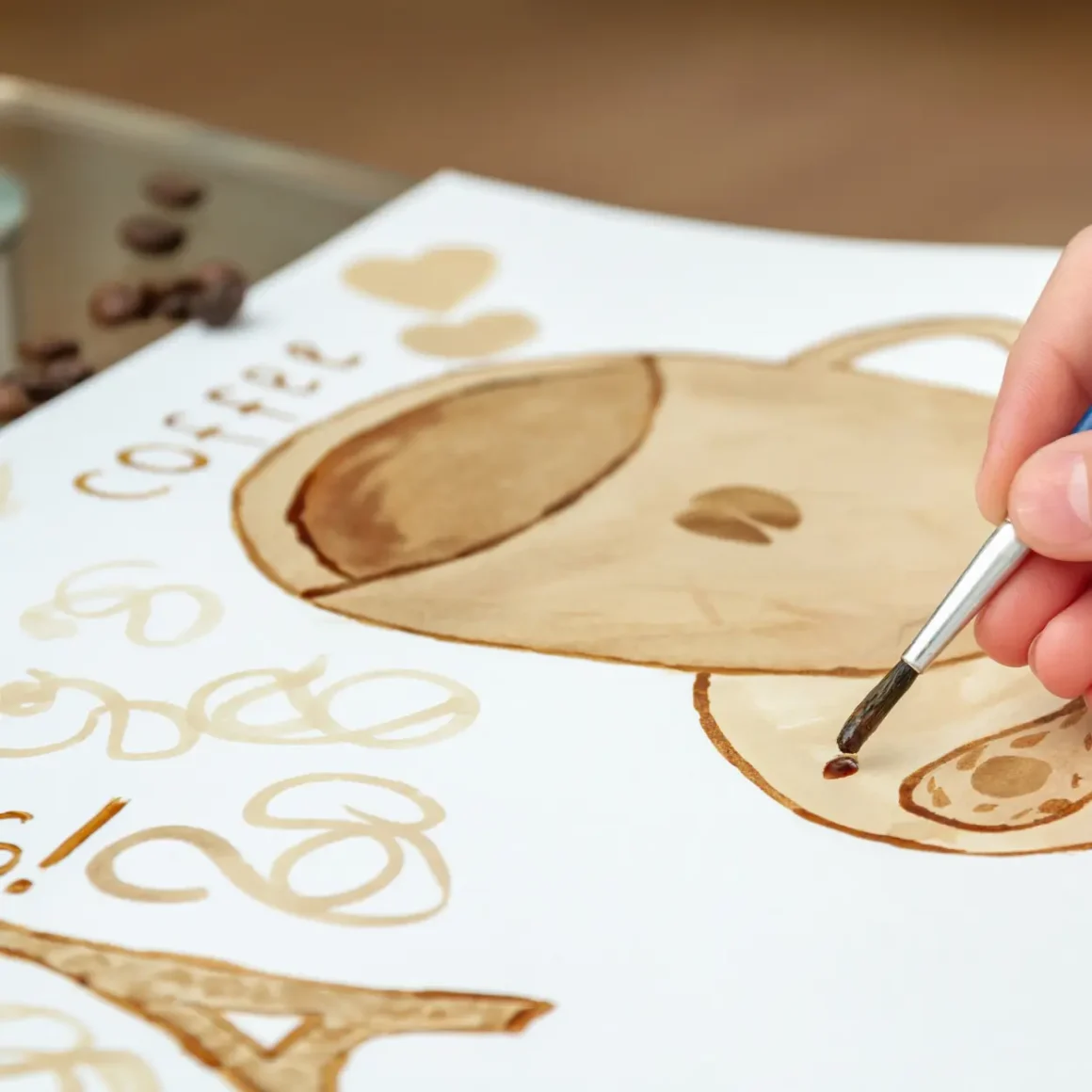
Coffee and milk is far more than just a delightful concoction; it’s a cultural icon that has impacted various aspects of modern life. Its influence reaches beyond the confines of the kitchen and café, touching realms like art, literature, and even competitive brewing. Let’s explore how this simple yet elegant coffee creation has left its imprint on today’s coffee culture.
The Coffee’s Impact on Art, Literature, and Music
Few beverages have as distinct a place in the world of art, literature, and music as this concoction. This isn’t merely a drink; it’s an experience, a mood, a setting that has inspired various forms of artistic expression.
Artistic Influence:
- Visual Arts: Artists often portray this beverage in their works, using the coffee’s rich tones as a backdrop for human interaction or as a focal point to illustrate daily life.
- Literary Appearances: From modern novels to classic literature, this coffee drink often appears as a symbol of leisure, conversation, or even intellectualism.
Musical Impact:
- Music Videos: The café setting often serves as an ideal background, capturing the casual yet intimate atmosphere that this drink represents.
Through its subtle yet lasting influence on art, literature, and music, this delicacy has established itself as more than just a drink—it’s a cultural staple.
Famous Coffee Shops and Their Signature Café au Lait Brews
Around the world, numerous coffee shops have gained fame for their unique takes on the classic coffee and milk.
Signature Brews:
- Parisian Cafés: In France, where this beverage originated, coffee shops often offer variations infused with local flavors or special kinds of milk.
- American Specialty Shops: In the United States, some establishments have even introduced seasonal options of this drink, incorporating ingredients like pumpkin spice or peppermint.
Iconic Locations:
- Global Chains: Starbucks, for example, has its own interpretation called the “Misto.”
- Local Legends: Independent coffee houses often distinguish themselves with artisanal versions of this beverage, elevating the traditional recipe with premium beans and artisanal milk options.
From big-name chains to local hideaways, this concoction has a versatile presence, each with its own twist to this timeless classic.
The National Café au Lait Day
On February 17th, coffee enthusiasts and aficionados have a reason to rejoice as it is recognized as National Café au Lait Day. This day celebrates the delicious blend commonly known in French as “coffee with milk.” This tradition of blending rich coffee with milk can be traced back to Europe, where the allure of milk became apparent. Historical records indicate that around 8000 B.C., milk from cows began its journey of transformation into various dairy products. European farmers played a pivotal role in recognizing and popularizing the goodness of milk.
For those looking to make the most of this day, here are some curated suggestions:
- Redefine Your Coffee Experience: Instead of your standard coffee, try the mesmerizing café au lait. This change can bring a touch of French sophistication to your caffeine routine.
- DIY Café au Lait: Don’t just buy; create! Dive into the art of making café au lait at home. With straightforward recipes available, this could be your moment of brewing perfection.
- French Getaway: Dreaming of a French escapade? Now might be the time. Experience the authentic taste of café au lait in the heart of France.
- Cultural Immersion: If traveling isn’t feasible, transport yourself to France by sipping your café au lait while indulging in classic French tunes.
- Home Decor: Elevate your kitchen aesthetics with a coffee-centric poster, reminding you of this aromatic blend every day.
- Social Buzz: Share your café au lait moments and join the global conversation with the hashtag #NationalCafeAuLaitDay.
Health Benefits and Considerations
Drinking this beverage can be more than just a delightful experience; it can also offer a range of health benefits as well as some considerations for caution. In this section, we will delve into the pros and cons of incorporating this drink into your diet and bust some common myths surrounding this popular beverage.
Pros of Incorporating Café au Lait in Your Diet

This coffee drink is not just a delicious brew; it has certain health advantages that can contribute to your overall well-being:
- Reduced Chronic Disease Risk: Consistent consumption of coffee, a key component in this concoction, has been linked with a decreased risk of developing chronic illnesses, including Alzheimer’s disease, type 2 diabetes, and certain forms of cancer. (3)
- Mental Clarity and Mood Enhancement: The caffeine found in coffee acts as a natural stimulant, which can help elevate your mood and enhance focus and alertness.
- Rich in Antioxidants: Coffee is packed with antioxidants that are known to combat oxidative stress, thereby protecting your body from inflammation and other ailments.
- Improved Physical Performance: The caffeine in this beverage can aid in increasing your energy levels, reducing fatigue, and enhancing your physical endurance.
- Nutritional Benefits: The milk used in this coffee contributes protein, calcium, and other essential nutrients to your diet, making it a nutritious choice.
Overall, This coffee drink can be a healthy addition to your diet, provided you’re aware of some of the considerations tied to its consumption.
Potential Health Concerns and Moderation

However, it’s crucial to recognize that while this beverage has multiple health benefits, there are also areas for caution:
- Caloric Content: This type of drink can be high in calories, especially if prepared with whole milk or sweeteners, which could be a concern for weight management.
- Lactose Intolerance: If you’re lactose intolerant, consuming this beverage could lead to digestive issues like bloating, gas, and diarrhea.
- Added Sugars: Some recipes of this coffee drink may include added sugars, which can lead to weight gain and other health concerns if consumed in large amounts.
- Acidic Nature: The inherent acidity in coffee may be problematic for individuals with digestive issues, such as acid reflux or GERD.
Hence, like any other food or beverage, moderation and awareness are key when incorporating this concoction into your diet.
Myths and Truths: Debunking Café au Lait Misconceptions
This beverage has its share of myths and misconceptions. Let’s set the record straight:
- Myth: Café au Lait is Packed with Sugar: Not necessarily. While some versions of this drink may contain added sugars, you can always opt for recipes that do not include sweeteners.
- Myth: It’s Unsuitable for Lactose-Intolerant Individuals: Not true. You can make this beverage with lactose-free milk or plant-based milk alternatives.
- Myth: Coffee and Milk Has Excessive Caffeine: Compared to regular black coffee, this coffee drink actually contains less caffeine due to the inclusion of milk, making it a milder option.
- Myth: It’s Not Nutritious: On the contrary, the milk in this beverage provides essential nutrients like calcium and protein, making it a nutritious option when consumed in moderation.
Being informed about what this delectable beverage actually offers can help you enjoy this delightful beverage in a way that aligns with your health goals.
Conclusion
The journey through the world of this delicacy has been a fascinating exploration of a French coffee tradition that is as elegant as it is simple. Despite the easy-to-master technique and minimalistic ingredients, the charm of this beverage is in its versatility and the richness it brings to the coffee culture. The correct pronunciation of café au lait (‘ka-fey oh-lei’) itself carries an exotic flair that transports you to a French café with every sip.
From understanding the nuanced impacts of choosing the right coffee beans and milk to mastering the tools and equipment for the perfect brew, we’ve delved into the minutiae that makes this beverage so beloved. We’ve also unearthed the health benefits and considerations one must keep in mind, busting a few myths along the way to enable you to enjoy this classic drink in a manner that aligns with your well-being.
So, the next time you’re yearning for a coffee experience that is both nutritious and steeped in cultural richness, remember this delicious coffee drink. It’s more than just a coffee; it’s a celebration of simplicity and elegance, right in your mug.
FAQ
What sets Café au Lait apart from a typical latte?
Each beverage combines coffee and milk; however, the former mixes steamed milk with drip coffee, whereas a latte begins with espresso.
Is there a vegan version of Café au Lait?
Yes, you can create a vegan version of this beverage by using plant-based milk alternatives, such as almond, oat, soy, or coconut milk.
What are some famous coffee houses known for their Café au Lait?
Café du Monde and Morning Call Coffee Stand in New Orleans are renowned for serving a delightful cup of this beverage, each with its unique twist.
How is the Café au Lait culture different in France compared to other countries?
In France, this coffee drink is a breakfast staple often paired with pastries, while in other countries, variations and serving styles adapt to local coffee cultures and preferences.
